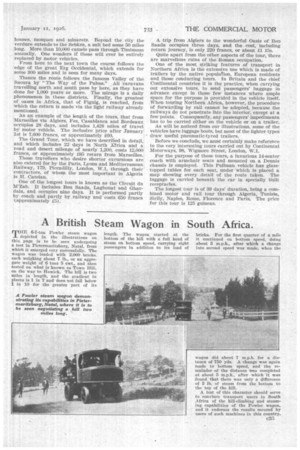A British Steam Wagon in South Africa.
Page 19

If you've noticed an error in this article please click here to report it so we can fix it.
THE 6-7-ton Fowler steam wagon depicted in the illustrations on this page is to be seen undergoing a test in Pietermaritzburg, Natal, from which it emerged very successfully. The wagon was •leaded with 2,000 bricks, each weighing about 7 lb., Or an aggregate weight of 6 tons 5 cwt., and then tested on what is known as Town Hill, on the way to Howich. The hill is two miles in length, and the gradient in places is 1 in 7 and does not fall below 1 in 10 for the greater part of its
length. The wagon started at the bottom of the bill with a full head of steam on bottom speed, carrying eight passengers in addition to its load of
bricks. For the first quarter of a mile it continued on bottom speed, doing about 5 m.p.h., after which a change into second speed was made, when the wagon did about 7 m.p.h. for a distance of 750 yds. A change was again made to bottom speed, and the remainder of the distance Nrus completed at about 5 m.p.h., after which it was found that there was only a difference of 5 lb. of steam from the bottom to the top of the hill.
A test of this character should serve to convince transport •users in South Africa of the hill-climbing and steaming capabilities of the Fowler wagon, and it endorses the results secured by users of such machines in this country.
































